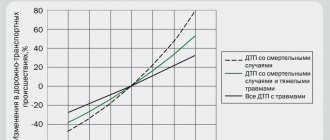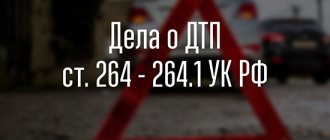Federal Law of December 10, 1995 No. 196-FZ
RUSSIAN FEDERATION
THE FEDERAL LAW
About road safety
Adopted by the State Duma on November 15, 1995
(As amended by federal laws dated March 2, 1999 No. 41-FZ, dated April 25, 2002 No. 41-FZ, dated January 10, 2003 No. 15-FZ, dated August 22, 2004 No. 122-FZ, dated December 18, 2006 No. 232-FZ, dated 08.11.2007 No. 257-FZ, dated 01.12.2007 No. 309-FZ, dated 30.12.2008 No. 313-FZ, dated 25.11.2009 No. 267-FZ, dated 23.07.2010 No. 169-FZ, dated 27.07.2010 No. 227-FZ, dated 04/21/2011 No. 69-FZ, dated 07/01/2011 No. 170-FZ, dated 07/11/2011 No. 192-FZ, dated 07/18/2011 No. 242-FZ, dated 07/19/2011 No. 248-FZ, dated 06/14/2012 No. 78-FZ, dated 07/28/2012 No. 131-FZ, dated 04/26/2013 No. 65-FZ, dated 05/07/2013 No. 92-FZ, dated 07/02/2013 No. 185-FZ, dated 07/23/2013 No. 196 -FZ, dated November 25, 2013 No. 317-FZ, dated December 28, 2013 No. 437-FZ, dated October 14, 2014 No. 307-FZ, dated June 8, 2015 No. 143-FZ, dated July 13, 2015 No. 233-FZ, dated November 28 .2015 No. 340-FZ, dated November 28, 2015 No. 357-FZ, dated April 5, 2016 No. 104-FZ, dated May 1, 2016 No. 126-FZ, dated July 3, 2016 No. 259-FZ, dated July 3, 2016 No. 296- Federal Law, dated July 26, 2017 No. 204-FZ, dated December 20, 2017 No. 398-FZ, dated December 29, 2017 No. 443-FZ, dated August 3, 2018 No. 283-FZ, dated October 30, 2018 No. 386-FZ, dated December 27. 2018 No. 508-FZ, dated 12/08/2020 No. 429-FZ)
Chapter I. General provisions
Article 1. Objectives of this Federal Law
This Federal Law defines the legal basis for ensuring road safety on the territory of the Russian Federation.
The objectives of this Federal Law are: protecting the life, health and property of citizens, protecting their rights and legitimate interests, as well as protecting the interests of society and the state by preventing road accidents and reducing the severity of their consequences.
Article 2. Basic terms
For the purposes of this Federal Law, the following basic terms are used:
road traffic is a set of social relations that arise in the process of moving people and goods with or without vehicles within the boundaries of roads;
road safety - the state of this process, reflecting the degree of protection of its participants from road accidents and their consequences;
road traffic accident - an event that occurred during the movement of a vehicle on the road and with its participation, in which people were killed or injured, vehicles, structures, cargo were damaged, or other material damage was caused;
ensuring road safety - activities aimed at preventing the causes of road accidents and reducing the severity of their consequences;
road user - a person directly involved in the process of road traffic as a driver of a vehicle, a pedestrian, or a passenger of a vehicle;
(Paragraph no longer in force - Federal Law dated December 29, 2017 No. 443-FZ)
a road equipped or adapted and used for the movement of vehicles - a strip of land or the surface of an artificial structure. The road includes one or more carriageways, as well as tram tracks, sidewalks, curbs and dividing strips, if any;
vehicle - a device intended for transporting people, goods or equipment installed on it on roads;
vehicle driver - a person driving a vehicle (including teaching how to drive a vehicle). The driver can drive a vehicle for personal purposes or as an employee or individual entrepreneur; (Paragraph introduced - Federal Law dated December 28, 2013 No. 437-FZ)
parking (parking space) - a specially designated and, if necessary, arranged and equipped place, which is, among other things, part of a highway and (or) adjacent to the roadway and (or) sidewalk, roadside, overpass or bridge, or which is part of underpass or underbridge spaces, areas and other objects of the road network, buildings, buildings or structures and intended for organized parking of vehicles on a paid basis or without charging a fee by decision of the owner or other owner of the highway, the owner of the land plot or the owner of the corresponding part of the building, structure or structure; (Paragraph introduced - Federal Law dated 01.05.2016 No. 126-FZ)
emergency-hazardous section of the road (place of concentration of traffic accidents) - a section of the road, street, not exceeding 1000 meters outside a populated area or 200 meters in a populated area, or the intersection of roads, streets, where three or more accidents occurred during the reporting year transport accidents of one type or five or more traffic accidents, regardless of their type, as a result of which people were killed or injured; (Paragraph introduced - Federal Law dated July 3, 2016 No. 296-FZ)
tachograph is a technical means of control that provides continuous, uncorrected recording of information about the speed and route of movement of a vehicle, about the time of driving and rest of the driver of the vehicle, about the work and rest schedule of the driver of the vehicle, the management of which is part of his job duties. (Paragraph introduced - Federal Law of October 30, 2018 No. 386-FZ)
Article 3. Basic principles of ensuring road safety
The basic principles of ensuring road safety are:
priority of the life and health of citizens participating in road traffic over the economic results of economic activity;
the priority of the state's responsibility for ensuring road safety over the responsibility of citizens participating in road traffic;
respecting the interests of citizens, society and the state while ensuring road safety;
program-targeted approach to activities to ensure road safety.
Article 4. Legal framework for road safety in the Russian Federation
(Name as amended by Federal Law dated July 11, 2011 No. 192-FZ)
The legislation of the Russian Federation on road safety consists of this Federal Law and other federal laws adopted in accordance with them, other regulatory legal acts of the Russian Federation, laws and other regulatory legal acts of the constituent entities of the Russian Federation, municipal legal acts. (As amended by Federal Law No. 192-FZ dated July 11, 2011)
Chapter II. State policy in the field of road safety
Article 5. Main directions of ensuring road safety
Ensuring road safety is carried out through:
establishing the powers and responsibilities of the Government of the Russian Federation, federal executive authorities, executive authorities of constituent entities of the Russian Federation and local governments; (As amended by Federal Law No. 192-FZ dated July 11, 2011)
coordination of the activities of federal executive authorities, executive authorities of constituent entities of the Russian Federation, local governments, public associations, legal entities and individuals in order to prevent road accidents and reduce the severity of their consequences;
regulation of activities in automobile, urban ground electric transport and road infrastructure;
development and approval in the prescribed manner of legislative and other regulatory legal acts on issues of ensuring road safety: technical regulations, rules, standardization documents adopted in accordance with the legislation of the Russian Federation on standardization, technical standards and other regulatory documents; (As amended by federal laws dated July 19, 2011 No. 248-FZ; dated April 5, 2016 No. 104-FZ)
carrying out traffic management activities;
material and financial support for road safety measures;
organizing training for vehicle drivers and educating citizens about traffic safety rules and requirements;
carrying out a set of measures for medical provision of road safety;
implementation of mandatory certification or declaration of conformity of vehicles, as well as structural components, items of additional equipment, spare parts and accessories of vehicles; (As amended by Federal Law No. 313-FZ dated December 30, 2008)
licensing of certain types of activities carried out in road transport in accordance with the legislation of the Russian Federation; (As amended by Federal Law No. 15-FZ dated January 10, 2003)
carrying out a socially oriented policy in the field of transport insurance;
implementation of federal state supervision in the field of road safety. (As amended by Federal Law No. 242-FZ dated July 18, 2011)
Article 6. Powers of the Russian Federation, constituent entities of the Russian Federation, local governments and owners of private roads in the field of ensuring road safety
(Name as amended by Federal Law dated July 3, 2016 No. 296-FZ)
1. The Russian Federation has jurisdiction over:
formation and implementation on the territory of the Russian Federation of a unified state policy in the field of ensuring road safety;
establishing the legal framework for ensuring road safety;
establishment of a unified system of technical regulations, rules, standardization documents adopted in accordance with the legislation of the Russian Federation on standardization, technical norms and other regulatory documents on road safety issues; (As amended by federal laws dated July 19, 2011 No. 248-FZ; dated April 5, 2016 No. 104-FZ)
control over the compliance of laws and other regulatory legal acts of the constituent entities of the Russian Federation in the field of ensuring road safety with the Constitution of the Russian Federation and federal laws;
creation of federal executive authorities to ensure the implementation of state policy in the field of road safety;
development and approval of federal programs to improve road safety and their financial support;
(Paragraph no longer in force - Federal Law of August 22, 2004 No. 122-FZ)
organization and implementation of federal state supervision in the field of road safety; (As amended by Federal Law No. 242-FZ dated July 18, 2011)
coordination of the activities of executive authorities of the constituent entities of the Russian Federation in the field of ensuring road safety;
conclusion of international treaties of the Russian Federation in the field of road safety.
2. The powers of federal executive authorities in the field of ensuring road safety are expenditure obligations of the Russian Federation.
Federal executive authorities, by agreement with the executive authorities of the constituent entities of the Russian Federation, may transfer to them the exercise of part of their powers in the field of ensuring road safety.
The powers of federal executive authorities in the field of ensuring road safety, provided for by this Federal Law, may be transferred for implementation to executive authorities of constituent entities of the Russian Federation by decrees of the President of the Russian Federation and resolutions of the Government of the Russian Federation in the manner established by Federal Law of October 6, 1999 No. 184- Federal Law “On the general principles of organization of legislative (representative) and executive bodies of state power of the constituent entities of the Russian Federation.” (Paragraph introduced - Federal Law dated July 13, 2015 No. 233-FZ)
The powers of the owners of public highways of federal significance, and in relation to highways transferred to the trust management of the State, the powers of the State in the field of ensuring road safety include the implementation of measures to ensure road safety on public highways of federal significance during the implementation of road activities , including the annual (until July 1 of the year following the reporting year) approval of lists of accident-prone road sections, and the development of priority measures aimed at eliminating the causes and conditions of road accidents. (Paragraph introduced - Federal Law dated July 3, 2016 No. 296-FZ)
(Clause as amended by Federal Law dated August 22, 2004 No. 122-FZ)
3. The powers of the executive authorities of the constituent entities of the Russian Federation in the field of ensuring road safety include the implementation of measures to ensure road safety on highways of regional or intermunicipal importance when carrying out road activities, including:
making decisions on temporary restrictions or cessation of vehicle traffic on roads of regional or intermunicipal importance in order to ensure road safety;
implementation of measures to prevent child road traffic injuries;
participation in the organization of training and retraining of vehicle drivers;
informing citizens about the rules and requirements in the field of road safety;
annual (before July 1 of the year following the reporting year) approval of lists of accident-prone road sections and development of priority measures aimed at eliminating the causes and conditions of road accidents. (Paragraph introduced - Federal Law dated July 3, 2016 No. 296-FZ)
The powers of the executive authorities of the constituent entities of the Russian Federation in the field of ensuring road safety are the expenditure obligations of the constituent entities of the Russian Federation.
The executive authorities of the constituent entities of the Russian Federation, by agreement with the federal executive authorities, may transfer to them the exercise of part of their powers in the field of ensuring road safety.
The powers of the executive authorities of the constituent entities of the Russian Federation - the federal cities of Moscow, St. Petersburg and Sevastopol in the field of ensuring road safety also include approval of the list of vehicles that are used to transport passengers and have, with the exception of the driver's seat, more than eight seats , the technically permissible maximum weight of which exceeds 5 tons and which are allowed to move in the lane for route vehicles. (Paragraph introduced - Federal Law dated December 20, 2017 No. 398-FZ)
The list of such vehicles and subsequent changes to it must be officially published in the manner established by the legislation of the federal cities of Moscow, St. Petersburg and Sevastopol, no later than thirty days before the date of entry into force of this list (changes to the list). (Paragraph introduced - Federal Law dated December 20, 2017 No. 398-FZ)
(Clause as amended by Federal Law dated July 11, 2011 No. 192-FZ)
4. The powers of local self-government bodies of urban settlements in the field of ensuring road safety include the implementation of measures to ensure road safety, annual (until July 1 of the year following the reporting year) approval of lists of emergency-hazardous sections of roads and the development of priority measures aimed at eliminating reasons and conditions for road traffic accidents on local roads, including at road network facilities, within the boundaries of urban settlements during road activities, including making decisions on temporary restrictions or cessation of vehicle traffic on local roads values within the boundaries of urban settlements in order to ensure road safety. (As amended by federal laws dated November 28, 2015 No. 357-FZ; dated July 3, 2016 No. 296-FZ)
The powers of local government bodies of a municipal district in the field of ensuring road safety include the implementation of measures to ensure road safety on local roads outside the boundaries of settlements within the boundaries of the municipal district when carrying out road activities, including:
making decisions on temporary restrictions or cessation of the movement of vehicles on local roads outside the boundaries of populated areas within the boundaries of a municipal district in order to ensure road safety;
participation in the implementation of measures to prevent child road traffic injuries in the territory of the municipal district;
annual (before July 1 of the year following the reporting year) approval of lists of accident-prone road sections and development of priority measures aimed at eliminating the causes and conditions of road accidents. (Paragraph introduced - Federal Law dated July 3, 2016 No. 296-FZ)
The powers of local self-government bodies of a municipal district in the field of ensuring road safety also include the exercise of powers established by the first paragraph of this paragraph in the territories of rural settlements, unless otherwise established by the law of a subject of the Russian Federation, as well as in inter-settlement areas. (Paragraph introduced - Federal Law dated November 28, 2015 No. 357-FZ)
The powers of local government bodies of the urban district in the field of ensuring road safety include the implementation of measures to ensure road safety on local roads, including at road network facilities, within the boundaries of the urban district when carrying out road activities, including:
making decisions on temporary restrictions or cessation of vehicle traffic on local roads within the boundaries of the urban district in order to ensure road safety;
annual (until July 1 of the year following the reporting year) approval of lists of accident-prone road sections and development of priority measures aimed at eliminating the causes and conditions of road accidents; (Paragraph introduced - Federal Law dated July 3, 2016 No. 296-FZ)
participation in the implementation of measures to prevent child road traffic injuries in the urban district.
The powers of local governments in the field of ensuring road safety are the expenditure obligations of municipalities.
(Clause as amended by Federal Law dated July 11, 2011 No. 192-FZ)
5. The powers of owners of private roads in the field of ensuring road safety include the implementation of measures to ensure road safety on private roads when carrying out road activities, including the annual (until July 1 of the year following the reporting year) approval of lists of emergency-hazardous sections of roads , and the development of priority measures aimed at eliminating the causes and conditions of road accidents. (Clause introduced - Federal Law dated July 3, 2016 No. 296-FZ)
Article 7. (Excluded - Federal Law of January 10, 2003 No. 15-FZ)
Article 8. Participation of public associations in the implementation of measures to ensure road safety
1. Public associations, associations
Essentially nothing new: changes to the road safety law have come into force
On December 21, 2018, amendments to the Law “On Road Traffic Safety” came into force. True, they are, rather, of a clarifying nature and do not yet threaten any fundamental changes (especially in the field of cargo transportation).
First of all, the amendments clarified that the requirements for equipping vehicles with tachographs, for drivers to comply with work and rest schedules, for them to undergo a medical examination, for ensuring the proper technical condition of the vehicle, etc. apply to all legal entities and individual entrepreneurs who have vehicles at their disposal.
That is: if, in accordance with the old formulation, all these requirements had to be fulfilled by “legal entities and individual entrepreneurs carrying out ... activities related to the operation of vehicles ,” now “legal entities, individual entrepreneurs operating vehicles .”
All legal entities and individual entrepreneurs, without exception, are, in addition, prohibited from hiring drivers who do not have a Russian driver's license . The only thing: this provision does not in any way apply to citizens from the EAEU states - Belarus, Kazakhstan, Armenia and Kyrgyzstan.
The amendments to the law also clarified: to carry out mandatory pre-trip or pre-shift monitoring of the technical condition of a vehicle, appoint a person responsible for ensuring road safety who has passed a special certification from among the employees, provide each vehicle with a parking space, etc. all legal entities and individual entrepreneurs carrying out transportation of goods or passengers. That is, not only those who are engaged in commercial transportation, but also those who transport goods and people for their own needs .
It is worth noting here that the law introduces mandatory pre-shift (and not just pre-trip) technical inspection of a vehicle and that vehicles returning from a trip within a city or urban settlement must be parked in strictly designated areas . The Ministry of Transport has already prepared an order that introduces requirements for such parking lots (one of the main ones is that they are located outside residential areas ), but what is noteworthy is that the amendments to the law have come into force, and the requirements of the Ministry of Transport will only take effect from January 1, 2020 .
What is also important: the law for the first time prescribed requirements for individuals operating vehicles weighing over 3.5 tons and with more than eight seats. Although for now these requirements for individuals are more general : analyze and eliminate the causes of accidents involving their vehicles, ensure their proper technical condition and maintenance in accordance with the manufacturer’s recommendations.
But from November 1, 2019, a provision will come into force that will oblige such vehicles to be equipped with tachographs .
True, here I would like more specifics from legislators, since the mention of vehicles weighing over 3.5 tons “hints” at trucks , while the requirement to equip vehicles of individuals with tachographs is being introduced as part of amendments regarding licensing of passenger transportation . Although the wording itself specified in the law does not correspond to any definition of the category of vehicles and includes characteristics of both passenger (the number of seats more than eight) and cargo (weighing more than 3.5 tons) vehicles.
Now, let us remind you that it is mandatory (Order No. 273 of the Ministry of Transport) that trucks weighing more than 3.5 tons used by legal entities and individual entrepreneurs .
Apparently, before November 1, 2019, the Ministry of Transport will make the appropriate changes to Order No. 273 - and then we will know for sure whether the new situation will affect the trucks of individuals or not.
And lastly: changes to the road safety law that came into force on December 21st gave traffic police officers the right to access tachographs .
General provisions of Federal Law 196
The Federal Law “On Road Traffic Safety” No. 196-FZ was adopted by the State Duma on November 15, 1995 based on the results of the third reading of the normative act under study. The then-current President of the Russian Federation signed the document under study on December 10, 1995. At the same time, the first official publication of the Federal Law on Road Safety in the Russian Federation appeared.
Read about current changes to Federal Law No. 115 here:
Federal Law 196 regulates the principles of ensuring road safety on the territory of the modern Russian Federation. The objectives of the Federal Law under consideration are:
- Protecting the health and lives of citizens;
- Defending property rights and freedoms;
- Prevention and mitigation of the consequences of road accidents.
The Federal Law on Road Traffic consists of 8 chapters and 33 articles. The structure of the studied normative act is as follows:
- Chapter 1 - Introductory provisions (Articles 1-4);
- Chapter 2 - State policy in the area under consideration (Articles 5-9);
- Chapter 3 - Programs to ensure road safety (Article 10);
- Chapter 4 - Requirements for ensuring safety on Russian roads (Articles 11-29);
- Chapter 5 - State supervision (Article 30);
- Chapter 6 - Liability for violation of the provisions of the Federal Law on Road Traffic (Article 31);
- Chapter 7 - International relations in the area considered by this normative act (Article 32);
- Chapter 8 - Final provisions (Article 33).
The new edition of Federal Law 196 was published on July 26, 2021.
Basic terminology of Federal Law 196
For the purposes pursued by the Federal Law of December 10, 1995 N 196-FZ (as amended on July 26, 2017) “On Road Traffic Safety,” the following basic terms are used:
- Road traffic is a combination of social relations that arise when drivers, passengers and goods move within roads;
- A road traffic accident (RTA) is an emergency event that results in damage to a vehicle and the death or injury of citizens;
- Road user - a person who is a driver, passenger of a vehicle or pedestrian;
- Road is a territory equipped for movement by cars;
- Vehicle - a machine designed for the overland transportation of people and goods;
- Parking space - a specially designated area, marked with a specific sign, on the territory of which the driver is authorized to park his vehicle;
- An accident-prone section of the road is a section with a total area of 200 to 1000 meters (depending on the population of a particular location), on the territory of which the largest number of accidents were recorded for the current year.
A complete list of the basic concepts used in the Federal Law under study is provided in Article 2 of the regulatory legal act under consideration.
Also read: Federal Law 25 Law on Municipal Service.
Federal Law on Transport Security as amended for 2018. Details at the link:










